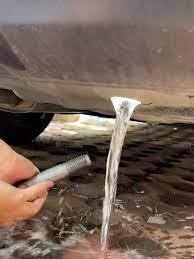Check the bottom of your car door. What you’re looking for is a small hole stamped in the steel. In some cases, it could have a small decal over it.
That hole (it’s actually a drain) can clog with debris. If it does clog, the door can’t drain or will it drain much, much more slowly than it fills up. Hence, slosh city in your door. In the case of some decal-covered holes, build-up can occur over time with tiny pieces of leaves and other stuff, so there could be sludge back there. Try to remove it if you can get at it with something pointy. A pen tip has worked for me.
A good way to test that you’ve solved the problem is to wait until the next soaker. If the hole was clogged and you removed the obstruction, water should drain right away. If it doesn’t, it might be time for a visit to the mechanic.
Question: How do I get rid of this ice out of my car door?!
Hi, I had a lot of sloshing sounds after the heavy rain somewhere around the front passenger side of the car.
Today, after a rain and snow it’s freezing and my rear passenger side floor is a real ice rink, the rag is covered with ice. All windows have a thick ice frost on the inside of the car as well.
What could be a cause and where should I bring my car?
Trending
Trick for Carrying Heavy Timber
Answer: How to remove ice out of your car door.
Ice in the car door takes an extra step to remove it. The ice in the car door will melt, eventually. If it’s too cold to melt, then try a hair dryer to help melt the ice. But, that doesn’t completely solve this morning’s problem.
So, open your car door(s) and look for a weep hole at the bottom. The weep hole on ours seems to have an adhesive flap over it that impeded water drainage (great design!). If you have one, make sure it opens.
On ours, I had to poke a hole in it. Once I did, water drained and the problem went away.
Some tips to remove water in the car door
Think like a rain drop. Water cooperates with gravity, so take advantage of this weakness with a few strategies.
Park on an incline.
If you can, park on an incline such that the weep hole is downhill. Water always finds the lowest point. Once it warms up and the water liquefies, this should help solve your problem.
see more on the next page
ADVERTISEMENT

